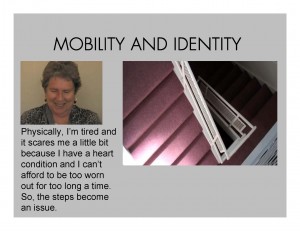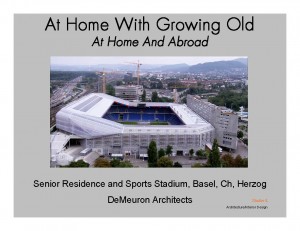(Presenters: Susanne Stadler, Architect , Cathy Spensley, Family Service Agency San Francisco, Jarmin Yeh, USCF)
Everyday life means often life at home as we get older. It seems intuitive that this home therefore has to be as supportive as possible of our ever changing needs, emotional as well as physical ones. Reality is a very different one – lowest-common-denominator thinking in housing developments and a lack of adaptability and resistance to change in private homes.
We believe that the reality could be a very different one if the people who shape the environment we grow old in understood how their creative solutions benefited the individual. Who would not be inspired to imaginative solutions if they knew that a well designed stair is not only about mobility but is also about exercise and opportunities for connecting with the community. Who would not want to give priority to imaginative solutions for an accessible entry to a home if they understood that not having an alternative to a stair may become a threat to a person’s identity if their beloved home is a 3rd floor walk up . Imaginative solutions can come both from spatial and social designs, such as through integrating or adding an elevator or providing the opportunity for people to rotate to an accessible apartment within their community.
Whatever we call the outcome, age friendly housing, design for aging in place, life long homes, it is essential to understand what home means to older adults through their own voices and through their own eyes in order to create sustainable, human centered solutions that come from an interdisciplinary and integrative approach to problem solving.
We presented a model for such interdisciplinary inquiry at the recent American Society on Aging (ASA) conference in Chicago. At the core of this presentation was the pilot “A Day In The Life”, a video self documentation of a group of older adults in San Francisco who filmed their home and were then interviewed about everyday life in their home. Findings and possible design responses were then discussed from the perspectives of Architecture, Social Services and Medical Sociology.
This project is not only an educational and advocacy tool but also has the potential to contribute to a bottom up theory generating process responding to the heightened interest the topic of age and place has garnered in the academic community, from medical sociology to geography.
We want to continue this project. Next we will ‘loop back’ our presentation to the protagonists, the people who shared their homes with us and get feedback from them. Then we will do a repeat performance to an interdisciplinary audience in San Francisco and connect with developers, social service providers, policy makers and funders to carry this project into different communities and continue to present to an interdisciplinary audience of elder, students and professionals and encourage others to follow suit.
For a complete view of the presentation and video go to ‘A Day In The Life’ – An Interdisciplinary Dialogue On Being At Home With Growing Old’ . We are looking forward to continuing the dialogue.

